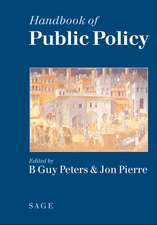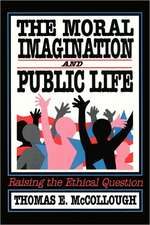The SAGE Handbook of Public Administration
Editat de B. Guy Peters, Jon Pierreen Limba Engleză Paperback – 27 apr 2014
The second edition has been fully revised and updated, with new chapters that reflect emerging issues and changes within the public sector:
- Identifying the Antecedents in Public Performance
- Bureaucratic Politics
- Strategy Structure and Policy Dynamics
- Comparative Administrative Reform
- Administrative Ethics
- Accountability through Market and Social Instruments
- Federalism and intergovernmental coordination.
A dominant theme throughout the handbook is a critical reflection on the utility of scholarly theory and the extent to which government practices inform the development of this theory. To this end it serves as an essential guide for both the practice of public administration today and its on-going development as an academic discipline.
The SAGE Handbook of Public Administration remains indispensable to the teaching, study and practice of public administration for students, academics and professionals everywhere.
| Toate formatele și edițiile | Preț | Express |
|---|---|---|
| Paperback (1) | 464.25 lei 6-8 săpt. | |
| SAGE Publications – 27 apr 2014 | 464.25 lei 6-8 săpt. | |
| Hardback (1) | 1149.44 lei 6-8 săpt. | |
| SAGE Publications – 19 aug 2012 | 1149.44 lei 6-8 săpt. |
Preț: 464.25 lei
Nou
Puncte Express: 696
Preț estimativ în valută:
88.86€ • 92.42$ • 74.46£
88.86€ • 92.42$ • 74.46£
Carte tipărită la comandă
Livrare economică 13-27 martie
Preluare comenzi: 021 569.72.76
Specificații
ISBN-13: 9781446295809
ISBN-10: 144629580X
Pagini: 816
Ilustrații: black & white line drawings, black & white tables, figures
Dimensiuni: 184 x 246 x 40 mm
Greutate: 1.27 kg
Ediția:Second Edition
Editura: SAGE Publications
Colecția Sage Publications Ltd
Locul publicării:London, United Kingdom
ISBN-10: 144629580X
Pagini: 816
Ilustrații: black & white line drawings, black & white tables, figures
Dimensiuni: 184 x 246 x 40 mm
Greutate: 1.27 kg
Ediția:Second Edition
Editura: SAGE Publications
Colecția Sage Publications Ltd
Locul publicării:London, United Kingdom
Recenzii
'Guy Peters and Jon Pierre are rightly regarded as leading figures in the area, but even that does not guarantee the striking breadth reflected in the company of contributors: this quality may be because the 14 separate areas covered in the volume are 'franchised' to separate expert (and geographically scattered) 'part editors' to coordinate and discuss entries. There is in consequence a similarly striking breath to the field reviewed. The title is somewhat 'retro' as the intellectual tradition is again reclaimed from policymaking, public sector management and other competing perspectives that have emerged. But while the label may be traditional, the content undermines any negatives associations that implies' -
Grant Jordan
Emeritus Professor of Politics, the University of Aberdeen
'If you are interested in a comprehensive yet compact and accessible account of current scholarly work on public sector organizations, this is the volume to have at hand. For this Handbook is not only a masterly and authoritatively selected collection of brilliant contributions, it also serves - interdisciplinary and comparative in outlook as it is - as a much needed cross-fertilizer between subfields of the public administration community' -
Eckhard Schroeter
Professor of Administrative Sciences, Zeppelin University
'Guy Peters and Jon Pierre and their colleagues have made an already essential handbook even more essential for students of public administration. New chapters on subjects such as administrative history, bureaucratic politics, representative bureaucracy, and intergovernmental relations add to the other excellent pieces to make for a magnificently comprehensive volume. Anyone interested in the administration of the contemporary state will want to read this volume and to have a copy of it at hand' -
Joel Aberbach
Distinguished Professor of Political Science and Public Policy, UCLA
Grant Jordan
Emeritus Professor of Politics, the University of Aberdeen
'If you are interested in a comprehensive yet compact and accessible account of current scholarly work on public sector organizations, this is the volume to have at hand. For this Handbook is not only a masterly and authoritatively selected collection of brilliant contributions, it also serves - interdisciplinary and comparative in outlook as it is - as a much needed cross-fertilizer between subfields of the public administration community' -
Eckhard Schroeter
Professor of Administrative Sciences, Zeppelin University
'Guy Peters and Jon Pierre and their colleagues have made an already essential handbook even more essential for students of public administration. New chapters on subjects such as administrative history, bureaucratic politics, representative bureaucracy, and intergovernmental relations add to the other excellent pieces to make for a magnificently comprehensive volume. Anyone interested in the administration of the contemporary state will want to read this volume and to have a copy of it at hand' -
Joel Aberbach
Distinguished Professor of Political Science and Public Policy, UCLA
Cuprins
Preface to Second Edition - B. Guy Peters and Jon Pierre
Introduction
Introduction: The Role of Public Administration in Governing - B. Guy Peters and Jon Pierre
PART ONE: PUBLIC MANAGEMENT: OLD AND NEW - Hal G. Rainey
Public Management - Laurence E. Lynn, Jr
Measuring Public-Sector Performance and Effectiveness - Carolyn J. Heinrich
Strategic Planning and Management - John M. Bryson
PART TWO: HUMAN RESOURCE MANAGEMENT - Patricia W. Ingraham
Identifying the Antecedents to Public Performance: Implications for Human Resource Management - Donald P. Moynihan
Global Trends in Human Resources Management Practices - Sally Coleman Selden
Pay and Prerequisites for Public Executives - Joergen Gronnegaard Christensen
Leadership and the Senior Executive Service from a Comparative Perspective - John Halligan
Labor Management Relations and Partnerships: Were They Reinvented? - James R. Thompson
PART THREE: ORGANIZATION THEORY AND PUBLIC ADMINISTRATION - Tom Christensen
How Bureaucratic Structure Matters: An Organizational Perspective - Morten Egeberg
Institutional Theories and Public Institutions: New Agendas and Appropriateness - Jean-Claude Thoenig
Formal Theory and Public Administration - Thomas H. Hammond and Jack H. Knott
Environmental Perspectives on Public Institutions - Karen M. Hult
PART FOUR: ADMINISTRATIVE HISTORY - Jos C. N. Raadschelders
US Administrative History: Golem Government - Mordecai Lee
Administrative Legacies in Western Europe - Fabio Rugge
South Asian and Western Administrative Experience: The Past in the Present - James Warner Bjorkman
PART FIVE: IMPLEMENTATION - Søren C. Winter
Implementation Perspectives: Status and Reconsideration - Søren Winter
Policy Design and Implementation - Peter J. May
Interorganizational Relations and Policy Implementation - Laurence J. O'Toole, Jr
Street-Level Bureaucrats and the Implementation of Public Policy - Marcia K. Meyers and Vibeke Lehmann Nielsen
PART SIX: LAW AND ADMINISTRATION - Gavin Drewry
The Continental System of Administrative Legality - Jacques Ziller
Administrative Law in the Anglo-American Tradition - Paul Craig
The Limits of Law: Can Laws Regulate Public Administration? - David Feldman
PART SEVEN: POLITICS AND ADMINISTRATION - Carl Dahlström
Bureaucratic Politics: Opening the Black Box of Executive Government - Paul 't Hart and Anchrit Wille
Politicization of the Civil Service - Luc Rouban
Strategy Structure and Policy Dynamics - Andrew B. Whitford
PART EIGHT: ADMINISTRATION AND SOCIETY - Bo Rothstein
Political Legitimacy for Public Administration - Bo Rothstein
Representative Bureaucracy: Four Questions - Kenneth J. Meier and K. Juree Capers
Street-Level Bureaucracy and Public Policy - Steven Rathgeb Smith
Electronic Government: A Revolution in Public Administration? - Helen Margetts
PART NINE: BUDGETING AND FINANCE: BUDGET WATCHER'S BLUES - Frans K. M. Van Nispen
Fiscal Rules and Fiscal Policy - Mark Hallerberg
Performance-Informed Budgeting: A Global Reform - Rita M. Hilton and Philip G. Joyce
Accrual Budgeting in Comparative Perspective - Leonard Kok
PART TEN: COMPARATIVE AND INTERNATIONAL PUBLIC ADMINISTRATION - Edward C. Page
Comparative Public Administration: From General Theory to General Frameworks - Marleen Brans
International Organizations and Domestic Administrative Reform - Dionyssis G. Dimitrakopoous and Agyris G. Passas
Administrative Patterns and National Politics - Martin Lodge
PART ELEVEN: ADMINISTRATIVE REFORM - Theo A. J. Toonen
Administrative Reform: Analytics - Theo A. J. Toonen
Administrative Reforms in Western Democracies - Tom Christensen and Per Laegreid
Comprehensive Reform and Public Administration in Post-Communist States - Tony J.G. Verheijen
PART TWELVE: PUBLIC ADMINISTRATION IN DEVELOPING AND TRANSITIONAL SOCIETIES - Goran Hyden
Public Administration in Africa: Deepening Crisis Despite Reform Efforts - Dele Olowu
Challenges of Culture and Governance in South Asian Public Administration - O. P. Dwedivi and D. S Mishra
Public Administration and Public Sector Reform in Latin America - Jorge Nef
Public Administration in Central and Eastern Europe - Patrycja Joanna Suwaj
PART THIRTEEN: ACCOUNTABILITY - Paul G. Thomas
Accountability in Modern Government - Robert Gregory
The Pursuit of Public-Service Ethics - Promises, Developments and Prospects - Christoph Demmke and Timo Moilanen
Accountability in an age of Markets and Networks - Mark Considine and Kamran Ali Afzal
PART FOURTEEN: INTERGOVERNMENTAL RELATIONS - Martin Painter
The Instruments of InterGovernmental Management - Beryl A. Radin
Federalism and Intergovernmental Coordination - Alan Fenna
Multi-level Governance and Public Administration - Simona Piattoni
Introduction
Introduction: The Role of Public Administration in Governing - B. Guy Peters and Jon Pierre
PART ONE: PUBLIC MANAGEMENT: OLD AND NEW - Hal G. Rainey
Public Management - Laurence E. Lynn, Jr
Measuring Public-Sector Performance and Effectiveness - Carolyn J. Heinrich
Strategic Planning and Management - John M. Bryson
PART TWO: HUMAN RESOURCE MANAGEMENT - Patricia W. Ingraham
Identifying the Antecedents to Public Performance: Implications for Human Resource Management - Donald P. Moynihan
Global Trends in Human Resources Management Practices - Sally Coleman Selden
Pay and Prerequisites for Public Executives - Joergen Gronnegaard Christensen
Leadership and the Senior Executive Service from a Comparative Perspective - John Halligan
Labor Management Relations and Partnerships: Were They Reinvented? - James R. Thompson
PART THREE: ORGANIZATION THEORY AND PUBLIC ADMINISTRATION - Tom Christensen
How Bureaucratic Structure Matters: An Organizational Perspective - Morten Egeberg
Institutional Theories and Public Institutions: New Agendas and Appropriateness - Jean-Claude Thoenig
Formal Theory and Public Administration - Thomas H. Hammond and Jack H. Knott
Environmental Perspectives on Public Institutions - Karen M. Hult
PART FOUR: ADMINISTRATIVE HISTORY - Jos C. N. Raadschelders
US Administrative History: Golem Government - Mordecai Lee
Administrative Legacies in Western Europe - Fabio Rugge
South Asian and Western Administrative Experience: The Past in the Present - James Warner Bjorkman
PART FIVE: IMPLEMENTATION - Søren C. Winter
Implementation Perspectives: Status and Reconsideration - Søren Winter
Policy Design and Implementation - Peter J. May
Interorganizational Relations and Policy Implementation - Laurence J. O'Toole, Jr
Street-Level Bureaucrats and the Implementation of Public Policy - Marcia K. Meyers and Vibeke Lehmann Nielsen
PART SIX: LAW AND ADMINISTRATION - Gavin Drewry
The Continental System of Administrative Legality - Jacques Ziller
Administrative Law in the Anglo-American Tradition - Paul Craig
The Limits of Law: Can Laws Regulate Public Administration? - David Feldman
PART SEVEN: POLITICS AND ADMINISTRATION - Carl Dahlström
Bureaucratic Politics: Opening the Black Box of Executive Government - Paul 't Hart and Anchrit Wille
Politicization of the Civil Service - Luc Rouban
Strategy Structure and Policy Dynamics - Andrew B. Whitford
PART EIGHT: ADMINISTRATION AND SOCIETY - Bo Rothstein
Political Legitimacy for Public Administration - Bo Rothstein
Representative Bureaucracy: Four Questions - Kenneth J. Meier and K. Juree Capers
Street-Level Bureaucracy and Public Policy - Steven Rathgeb Smith
Electronic Government: A Revolution in Public Administration? - Helen Margetts
PART NINE: BUDGETING AND FINANCE: BUDGET WATCHER'S BLUES - Frans K. M. Van Nispen
Fiscal Rules and Fiscal Policy - Mark Hallerberg
Performance-Informed Budgeting: A Global Reform - Rita M. Hilton and Philip G. Joyce
Accrual Budgeting in Comparative Perspective - Leonard Kok
PART TEN: COMPARATIVE AND INTERNATIONAL PUBLIC ADMINISTRATION - Edward C. Page
Comparative Public Administration: From General Theory to General Frameworks - Marleen Brans
International Organizations and Domestic Administrative Reform - Dionyssis G. Dimitrakopoous and Agyris G. Passas
Administrative Patterns and National Politics - Martin Lodge
PART ELEVEN: ADMINISTRATIVE REFORM - Theo A. J. Toonen
Administrative Reform: Analytics - Theo A. J. Toonen
Administrative Reforms in Western Democracies - Tom Christensen and Per Laegreid
Comprehensive Reform and Public Administration in Post-Communist States - Tony J.G. Verheijen
PART TWELVE: PUBLIC ADMINISTRATION IN DEVELOPING AND TRANSITIONAL SOCIETIES - Goran Hyden
Public Administration in Africa: Deepening Crisis Despite Reform Efforts - Dele Olowu
Challenges of Culture and Governance in South Asian Public Administration - O. P. Dwedivi and D. S Mishra
Public Administration and Public Sector Reform in Latin America - Jorge Nef
Public Administration in Central and Eastern Europe - Patrycja Joanna Suwaj
PART THIRTEEN: ACCOUNTABILITY - Paul G. Thomas
Accountability in Modern Government - Robert Gregory
The Pursuit of Public-Service Ethics - Promises, Developments and Prospects - Christoph Demmke and Timo Moilanen
Accountability in an age of Markets and Networks - Mark Considine and Kamran Ali Afzal
PART FOURTEEN: INTERGOVERNMENTAL RELATIONS - Martin Painter
The Instruments of InterGovernmental Management - Beryl A. Radin
Federalism and Intergovernmental Coordination - Alan Fenna
Multi-level Governance and Public Administration - Simona Piattoni
Descriere
Now available in paperback: With a particular focus on the utility of scholarly theory and the extent to which government practices inform the development of this theory, this second edition provides a complete review and guide to past and present knowledge in the field


















